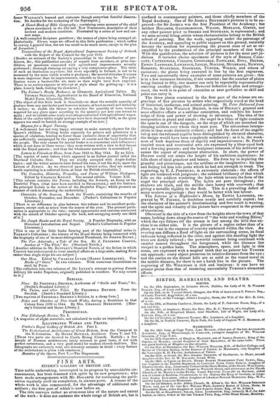FINE ARTS.
FINDEN'S GALLERY OF BRrnsii ART.
Taut noble undertaking, interrupted in its progress by unavoidable cir- cumstances, has been resumed with spirit by its new proprietors ; who have made arrangements with Mr. HOGARTH for continuing the publi- cation regularly until its completion, in sixteen parts. A reissue of the -whole work is also commenced, for the advantage of additional sub- scribers ; the first part of which ic now before us. The title conveys rather an erroneous idea of the nature and extent of the work : it does not embrace the whole range of British art, but is confined to contemporary painters, and those chiefly members of the Royal Academy. One of Sir JOSHUA REYNOLDS'S pictures is to be en- graved—for Sir JOSHUA was the first President of the Academy; but neither HOGARTH, GAINSBOROUGH, WILSON, MORLAND, GIRTIN, nor any other painter prior to SMIRKE and STOTHARD, is represented ; and we miss several living artists whose characteristics belong to the British school of painting. But the work, appearing under the patronage of
the Academy, and appealing to public support on this ground, naturally became the medium for representing the present state of art as ex- emplified by the productions of the principal members of that body. With this qualification, the selection of pictures is for the most part ju- dicious. It includes choice specimens of the style of BRIGGS. CALL- COTT, CATTERMOLE, COLLINS, CONSTABLE, EASTLAKE, ETTY, HILTON, EDWIN LANDSEER, LAWRENCE, LESLIE, MACLISE, MULREADY, NEWTON, ROBERTS, STANFIELD, STOTHARD, TURNER, WILKIE, and others of eminence ; the plates being executed in line by the first engrave's. Two and occasionally three examples of some painters are given : this is in a few instances desirable, if not essential ; but the number of plates being limited to fifty, one master can only be repeatedly represented by omitting another altogether. However defective in plan and arrange- ment, the work is in point of execution as near perfection as skill and pains can carry it.
The three plates contained in the first part of the reissue are en- gravings of fine pictures by artists who respectively stand at the head of historical, landscape, and animal painting. St. Peter Delivered from Prison, by the late WILLIAM HILTON, is one of HILTON'S greatest and most effective efforts at a sublime conception, and exhibits his know- ledge of form and power of drawing to advantage. The idea of the composition is grand and simple : the angel in a blaze of light conducts the apostle out of the dungeon, on the steps of which are stretched the sleeping soldiers over whom they must pass. The miraculous interpo- sition is thus made distinctly evident ; and had the faces of the angelic being and the released captive been distinguished by elevated character, the design would have been completely satisfactory : as it is, the weak- ness of both deprives them of dignity and impressiveness : St. Peter's dazzled sense and reverential awe are expressed by a blear-eyed look and a fawning posture ; and the benignant calmness of his deliverer as- sumes the aspect of complacent abstraction. In short, the power of HILTON could not attain the height of his ambitious aspirations : he falls short of ideal grandeur and beauty. His forte lay in depicting the graceful and picturesque, not the sublime or the imaginative : his taste and feeling led him into paths which he had not strength to tread. The engraving, by E. J. PORTBURY, is extremely elaborate : the effects of light are rendered with judgment ; the subdued brilliancy of that which falls on the soldiers rendering the halo which invests the form of the angel the principal object. The lights are pure throughout ; the shadows are black, and the middle tints heavy with overwork ; thus giving a metallic rigidity to the flesh. This is a prevailing defect of many modern engravings : they would be better with less labour. The Interior of a Highlander's House, by EDWIN LANDSEER, en- graved by W. FINDER, is doubtless neatly and carefully copied ; but the character of the painter's discriminating and free touch is wanting, and the spirit and vivacity of the picture have evaporated in the process of translation.
Oberwesel is the title of a view from the heights above the town of that name, looking down along the course of "the wide and winding Rhine," which the eye follows till the stream is lost among the hills that en- close it on either side. It is the picture of a region rather than of i place, so vast is the expanse of country embraced within the view. An evening sun diffuses a flood of light on the surrounding scene, its focal radiance being reflected in the river, and against this dazzling light the trees are darkly relieved ; the powerful contrast being continued with smaller masses throughout the foreground, while the distance lies steeped in a golden haze. The atmosphere, space, and light in this scene, are expressed with a magical truth that no painter but TURNER can approach : every object preserves its relative distance from the eye; and the castles on the distant hills are as solid as the round tower in the middle distance, for there is not a harsh line in the picture. The engraving of Mr. WILLMORE is rich and luminous : it can have no greater praise than that of rendering successfully TURNER'S elemental effects.


























 Previous page
Previous page